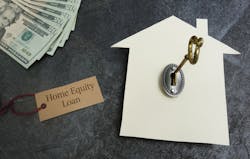The consumer cost for a new comfort system has doubled over the past few years. Inflation, supply chain issues, and especially, government regulations have all combined to hammer the consumer. Except for the extremely affluent, almost all consumers will need some form of financing to be able to replace their comfort systems. HVAC salespeople need to become conversant with financing to close sales today.
Revolving Credit
In the past, all manufacturer financing was revolving. This is identical to buying with a credit card. Each month, the consumer mustInstallment Financing
Installment financing is replacing revolving as the preferred method for HVAC. It is identical to the typical fixed rate mortgage. There is a fixed number of payments (i.e., the term) at a given interest rate. At the end of the payments, the note is paid.
For relatively short term loans (i.e., five years or less), revolving credit with a 2% payment will result in lower payments. Beyond 60 months, installment financing results in lower payments than revolving credit. It makes sense to offer extended term financing. This better aligns the payments of the comfort system with the life of the system.
A $15,000 comfort system under a revolving plan with a 2% minimum payment and 9% annual interest requires an initial payment of $300. This is roughly the same for an installment plan with a 60 month term. Frankly, if the consumer makes the $300 payment each month on the revolving plan, he will pay off the note in 60 months.
Extended term financing better aligns the payments of the comfort system with the life of the system.
Things change when the term extends beyond 60 months. At 96 months, an installment note will lower the payment to $220. At 120 months (i.e., 10 years), the payments drop to $190.
Extended term financing allows the homeowner to lower his payment. Alternatively, the homeowner could keep the payment the same or reduce it slightly and buy a better comfort system with IAQ accessories, connected home products, extended warranties, higher efficiency equipment, or any other enhancements the homeowner desires.
Second Look Financing
Many consumers are credit challenged. When they fail to receive approval, special lenders will give the credit application a “second look.” When approved, there are usually accompanying conditions, such as a lower credit limit. The contractor may change the comfort system offering to reduce its price and/or reduce margins to help the consumer acquire a comfort system. Many of today’s HVAC lenders have tie-ins with second look lenders so that the application automatically cascades down to the second look lender if the initial credit application is denied. HVAC salespeople need to be familiar with second look lenders and the process to send a rejected credit applicant to one.
Home Equity Loans
If a homeowner has equity in his home (i.e., it is worth more than the mortgage), he can borrow against the equity in the home. SomeUtility Loans
In some areas, utilities have special financing available for energy efficiency improvements. The utility programs vary widely. Salespeople should be conversant with the programs for each utility in a market areas.
Equipment Leasing
A “new” type of lending program has emerged lately. It is equipment leasing. Consumers often incorrectly associate equipment leasing with car leasing. In a car lease, the borrower is paying for the anticipated depreciation of the vehicle for a fixed period of time, given a certain number of miles driven. Equipment leasing is really just installment financing with a cash buyout at the end of the term. TheTurndowns are Not an Issue
Many contractors hesitate to offer financing out of fear that lenders will reject a borrower due to bad credit. These borrowers typically know they have bad credit, but are unable to buy a system any other way and there is a chance that second look programs or a home equity loan will succeed. It is unlikely they will be able to buy a new system otherwise.
By refusing to offer financing, you are requiring the homeowner to find it on their own. If they qualify with you, the odds are better they will buy from you. If they qualify on their own, they can buy from anyone. In addition, marketing research has consistently shown that consumers who finance their purchases through a contractor spend significantly more.
Are you attending the Service World Expo October 3-6? It is the biggest and best conference and show focused on the residential service and replacement side of the business. Register today at www.ServiceWorldExpo.com.
About the Author
Matt Michel
Chief Executive Officer
Matt Michel was a co-founder and CEO of the Service Roundtable (ServiceRoundtable.com). The Service Roundtable is an organization founded to help contractors improve their sales, marketing, operations, and profitability. The Service Nation Alliance is a part of this overall organization. Matt was inducted into the Contracting Business HVAC Hall of Fame in 2015. He is now an author and rancher.



